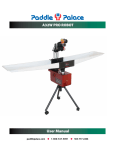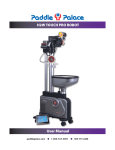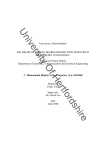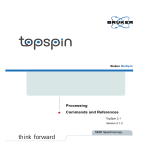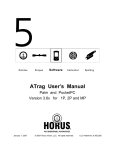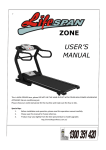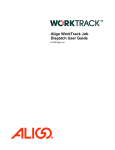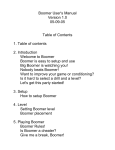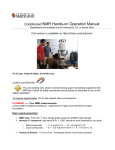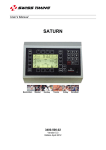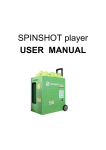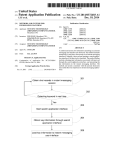Download User Manual - Megaspin.net
Transcript
S4W PRO ROBOT User Manual paddlepalace.com 1-800-547-5891 503-777-2266 Taking Robot Technology to the Next Level The Paddle Palace S4W Pro takes robot technology to the next level. This innovative robot has two heads, each with two throw wheels. Both heads, and the four throw wheels, are all independently programmable, allowing you great flexibility in designing playing patterns and practice options. You can program a seamless combination of topspin and underspin (or side-spin or no-spin) shots in the same play sequence. The S4W Pro comes with an easy to use, comprehensive control box, conveniently located at the player’s end of the table. This heavy duty robot is durable for club and home use. It is ready to use right out of the box. With the S4W Pro, you can use one or both heads to produce desired practice patterns. Use the single head to set up a specific serve or volley, or employ both heads to alternate seamlessly between types of spin, short and long balls, strong and weak balls, or high and low balls. Plus, you choose the landing spot locations, as well as the speed and throw frequency. You can set up one head to reproduce a realistic serve that hits the robot side of the table first, then complete the sequence with volleys from the 2nd head. See paddlpalace.com for all the details! Two heads and four throw wheels Heads and throw wheels can be set independently for speed, spin, and landing spots on consecutive shots Topspin, underspin, sidespin, and no spin--plus serves--can be programmed into your custom training pattern Set your own, or use 30 pre-programmed sets of landing location sequences Short & long balls, strong & weak balls, or high & low balls can be combined in one training sequence Remote control box on player side of table Random sequence mode for the ultimate challenge Memory function saves current settings for next practice session Ball recycling and net collection system Easy set up, and rolls from table for convenient storage PADDLE PALACE ROBOTS INCLUDE: Free 120 Nittaku Balls Free Ball Pick-up Net Free Robot Training DVD Item OPVS4 Free shipping to contiguous USA 30-day money-back Guarantee One year limited Warranty Paddle Palace S4W Robot page 3 User Manual Table of Contents 4 Robot Components / Features 5 How to Assemble the Ball Catch Net 5 The Power Supply 6 Control Box Features 6 Setting the Total Number of Balls 6 Setting the Frequency 7 Setting the Head Angle (Loop) 7 Setting the Type of Spin (Head Rotation) 8 Setting Throw Wheel Speed 8 Selecting Pre-Programmed Landing Sequences (Various Serving Sequence) 8 Selecting (Random) Landing Spot Sequences 9 Selecting the Landing Spot Locations 9 Setting Landing Spot Locations for 1 Head and 2 Heads 10 Setting Single Head Serve 10 Setting Double Head Serve 11 How to Maintain Your New Robot 11 Quick Start Guide 12 General Warning/Safety Issues 12 Trouble-Shooting 13 30 Pre-Programmed Landing Sequences 800-547-5891 503-777-2266 www.paddlepalace.com Paddle Palace S4W Robot page 4 User Manual PADDLE PALACE S4W PRO ROBOT Robot Components / Features This manual has been written to help you enjoy and get the most out of your new Paddle Palace Robot. Take time to read these pages thoroughly and keep it handy for reference when using your robot. 1. Top Throw Wheel for Shooting Head 1 7. Loop Adjustment Knob 5. Bottom Throw Wheel for Shooting Head 1 3. Shooting Head 1 2. Top Throw Wheel for Shooting Head 2 4. Shooting Head 2 6. Bottom Throw Wheel for Shooting Head 2 8. Ball Catch Net Support Connector 9a. Ball Container [top view] Poke Bar 9. Ball Container The Ball Container will hold approximately 100 40mm balls. The level of the balls in the container should not be higher than the label (yellow line) positioned inside. Foreign objects should not be put into the ball container as they could damage the internal parts which would adversely affect normal operation of the robot. 10. Power Switch 11. Control Box 12. Control Box Support Bracket 13. Ball Catch Net page 5 Paddle Palace S4W Robot User Manual How to assemble the Ball Catch Net Net Hardware: A A 2 Net Supports that clamp on either side of table B Control Box Support B 1. Unlock the buckle that holds the two halves of the Ball Catch Net together. 2. Partially unfold the Ball Catch Net and carefully slip it over the robot head. Insert the double pin into the net support connector located on the robot frame. 3. Open and spread out both sides of the net. 4. Always unlock the robot wheels before moving the robot. Roll the robot to the table. 5. Slip the sleeves of the ball net over the net support clamps. 6. Clamp net supports to the table near the net and slip the elastic band over the net support knob. 7. To store the robot, fold the Ball Catch Net and lock the buckles. Unlock the wheels and roll the robot away. The Power Supply The robot is powered by standard US home current (120V). Make sure the power cord is securely plugged in. The on/off switch is located on the backside of the robot. Turn off and unplug the robot when not in use. page 6 Paddle Palace S4W Robot User Manual S4W Control Box Total Number of Balls Shooting Head 1 Adjustment Keys (Increase/Decrease) Various Serving Sequence Selection Menu Shooting Head 2 Adjustment Keys (Increase/Decrease) Increase/ Decrease Top-Wheel Speed Shooting Head 2 Top-Wheel Speed Shooting Head 1 Bottom-Wheel Speed Shooting Head 2 Bottom-Wheel Speed Shooting Head 1 Frequency Indicator (Increase/Decrease) Ball Counter 1 Ball Counter 2 START/PAUSE Landing Spot Locations [11 Positions] Set Landing Spot Sequences in Random Setting the Total Number of Balls This is the total number of balls served by both Shooting Heads. With the robot in Standby mode, set the total number of balls by pressing the Total Number of Balls button. Change the number by using the “Up” or “Down” buttons. For fast-forward adjustment, hold either button down. The range of output is from 1 to 999 balls. When the robot starts, the ball countdown begins. When the counter reaches “0”, the robot stops and goes to Standby mode. Turn off counter to set ball count to “Infinite” (unlimited). Total Number of Balls Setting the Frequency Ball frequency can be adjusted in either Standby or Working mode. Press the Frequency (+) button to increase, or Frequency (-) button to decrease frequency. There are 10 possible settings. The slowest (1) produces approximately 25 balls per minute. The fastest setting (10) produces approximately 95 balls per minute. Paddle Palace S4W Robot page 7 User Manual Setting the Head Angle (Loop) Head Angle Lock Loosen the Head Angle Lock knob with one hand while adjusting the head angle using the Loop Adjustment Knob. Tighten the Head Angle Lock knob to hold head at desired angle. Set the head angle upward to deliver the ball directly. Set the head angle downward and the ball will bounce on the robot side of the table before crossing the net. Use this setting to practice service returns, the speed and spin is slightly reduced because of this extra bounce. Loop Adjustment Knob Low curve makes landing spot short High curve makes landing spot long Setting the Type of Spin (Head Rotation) Top and Bottom Throw Wheels Each of the two shooting heads can be set to produce one of 9 different types of spin. Top Spin, Under Spin, and No Spin are produced by varying the speed of the top and bottom throw wheels. Left-side spin, right-side spin, left-side top spin, left-side under spin, right-side top spin, and right-side under spin are achieved by rotating the shooting heads. When rotating a head, be sure it does not interfere with the operation of the other head. Both heads cannot be set to straight side spin at the same time. Paddle Palace S4W Robot page 8 User Manual Setting Throw Wheel Speed (Amount of Speed and Spin) Top Wheels Bottom Wheels Wheel speed can be set in either Working or Standby mode. The top and bottom wheel display will blink the current settings when the robot is in Standby mode. The wheel speeds are changed by pressing the “Increase” or “Decrease” buttons. The speeds of the top and bottom throw wheels determine the speed and amount of spin, or lack of spin, of the ball delivery. Each wheel has 10 numeric settings. The higher the setting the faster the ball speed becomes. The ball speed is roughly proportional to the strength of spin. To produce topspin, the top wheel is set at a higher number than the bottom wheel. To produce under spin, the bottom wheel is set higher than the top. Less or no spin is produced when the wheel speeds are set closely together. To practice against heavy under spin shots (chopping), a very realistic chop can be created by moving the robot away from the table a few feet. This also works for lobbing. Shot Examples: Topspin ball with Medium Speed and Medium amount of Topspin – Set the top wheel at 5 and the bottom wheel at 2. Topspin ball with Faster Speed and Medium amount of Topspin – Set the top wheel at 7 and the bottom wheel at 3. Medium Speed ball with Heavier Topspin – Set top wheel to 7, bottom wheel to 1. ROBOT TIP: The bigger the difference in setting between the top and bottom wheels, the more the spin is produced. Selecting Pre-Programmed Landing Sequences (Various Serving Sequence) Up/Down Various Serving Sequence The Various Landing Sequence is set in Standby mode. By pressing the Various Serving Sequence button you can select one of the 30 numbered sets of Pre-Programmed Landing Sequences listed on page 13. A red LED light will come on when this feature is activated. Press the “Up” or “Down” arrow buttons until the number of your desired sequence shows in the display. Set the head angle and type of spin to suit your training needs for each landing sequence. Use the ball counter to set the number of balls you want to play for each sequence. Turn off the ball counter for unlimited play. Selecting (Random) Landing Spot Locations Sequences Sequences in Random Landing Spot Locations The Random Landing Spot Locations Sequence is set in Standby mode. Activate this feature by pressing the Sequences in Random button. A red led light will come on. The robot will randomly select one of the 30 pre-programmed sequences and rearrange the serving order to form a new sequence. This feature will produce thousands of different sequences. (List of 30 Pre-Programmed Landing Sequences on page 13. Paddle Palace S4W Robot page 9 User Manual Selecting the Landing Spot Locations (Program Your Own Sequence) Set Landing Spot Landing Spot Locations Setting Landing Spot Locations for 1 Head (program your own sequence) 1. Press Landing Spot button. 2. Press Location buttons 1-11 in the sequence you wish to play. 3. When you are done, press Start. Setting Landing Spot Locations for 2 Heads (program your own sequence) 1. Set Ball Counter for Head 1 by pressing the “+” or “-”. 2. Press Landing Spot button. 3. Set Landing Spot Locations. Press Location buttons to set Head 1. 4. Set Ball Counter for Head 2 by pressing the “+” or “-”. 5. Press Location buttons up to 9 times 6. When you are done, press Start. IMPORTANT NOTE: The robot will serve head one’s entire sequence first, then serve head two’s entire sequence. When head two’s sequence has been completed the robot will repeat the serving order beginning with head one followed by head two. FOR 1 HEAD The Landing Spot Locations Sequence is set in Standby mode. There are 11 numbered buttons on the bottom of the control box. These buttons indicate 11 locations (landing spots) on the table where the robot will deliver balls. The blue area surrounding the buttons represents the receiving end of the table. To program a sequence, first press the Landing Spot button. All of the 1-11 location lights will be off at this point. Press the Location button for where you want the first ball of your sequence to land (for example, press Location 3). The red led light for that location (3) will come on. Press another location button (for example Location 8). The second ball of your sequence will land at location 8. Press 8 again and the third ball will land on location 8. The number of balls that land on the same spot depends on how many times you press that location button. When done, start the robot (Start button). Your sequence will play, then repeat, until the ball counter gets to zero. Robot memory function will keep current settings next time you play. FOR 2 HEADS Before setting the Landing Spot Locations sequence for both heads, make sure you have a sufficient supply of balls in the ball container. An insufficient supply of balls in the ball container will cause the Landing Spot Locations sequence to work improperly. The Landing Spot Locations Sequence is set in Standby mode. There are 11 numbered buttons on the bottom of the control box. These buttons indicate 11 locations (landing spots) on the table where the robot will deliver balls. The blue area surrounding the buttons represents the receiving end of the table. To program a landing spot locations sequence for both heads, set the Ball Counter for Head 1 by pressing the “+” or “-“ adjustment keys until you reach the number of balls you want the robot to put into play from Head 1. Next press the Landing Spot button. IMPORTANT! ONLY PRESS THE LANDING SPOT BUTTON ONCE WHEN SETTING BOTH HEADS. Set the Landing Spot Locations sequence for Head 1 by pressing the Location buttons to locate the placement of balls shooting from Head 1. IMPORTANT! MAKE SURE THE NUMBER OF BALLS SET FOR HEAD 1 MATCHES THE NUMBER OF LANDING SPOTS PRESSED FOR HEAD 1. (i.e. If the ball counter for Head 1 is set for 6 balls then 6 landing positions must be selected for Head 1 sequence). Set the Ball Counter for Head 2 by pressing the “+” or “-“ adjustment keys until you reach the number of balls you want Head 2 to put into play. Then set the Landing Spot Locations sequence for Head 2 by pressing the Location buttons to locate the placement of balls for Head 2. IMPORTANT! MAKE SURE THE NUMBER OF BALLS SET FOR HEAD 2 MATCHES THE NUMBER OF LANDING SPOTS PRESSED FOR HEAD 2. (i.e. If the ball counter for Head 2 is set for 8 balls then 8 landing locations must be selected for Head 2 sequence). When you have completed this process press Start to begin play. Paddle Palace S4W Robot page 10 User Manual Setting Single Head Serve 1. Set the Ball Counter of one shooting head to infinity. Press and hold the (+) button until a dash appears. 2. Set the Frequency press (+) to increase (-) to decrease. 3. Set the Head Angle (Loop) - illustration below Frequency 4. Set the type of Spin (spin indication) - See page 5 5. Set the Throw Wheel Speed (amount of speed and spin) 6. Set the Landing Spot Locations. 7. Press Start/Pause button to start robot Ball Counter When changing the loop of the serve, loosen the Loop Lock Knob before adjusting the Loop Modulation Wheel. When achieving your desired loop, lock the knob. High curve = landing spot long Low curve = landing spot short Setting Double Head Serve The control box automatically stores the current settings when the robot is turned off and will start with those settings next time the robot used. 1. 2. 3. 4. Total Number of Balls 5. 6. 7. Shooting Head 1 Shooting Head 2 8. Set the Total Number of Balls. Set the Frequency. Set the Head Angle (loop) for Shooting Heads 1 and 2. Set the type of Spin, rotate the Shooting Heads until the spin indicator points to the type of spin wanted. Set both heads. Set the Throw Wheel Speeds (amount of speed and spin) for Shooting Heads 1 and 2 Select the Landing Spot Location Sequence you want to use. You have three options: Random, Pre-Programmed (various), or you can program your own landing spot sequence. If you set “Random” in step 6 you are done. Press the “Start/Pause” to start robot. If you set “Various” use the “Up” or “Down” buttons to choose one of the 30 sequences (See page 13). If you chose to program your own Landing Spot Sequence in Step 6, set the ball counter for Head 1. 9. Push Landing Spot button ( IMPORTANT! PRESS LANDING SPOT BUTTON ONLY ONCE WHEN SETTING BOTH HEADS ) Landing Spot Landing Spot Locations Sequences in Random 10. 11. 12. 13. Set landing spot locations for Head 1. Set ball counter for Head 2 Set landing spot locations for Head 2 Press “Start/Pause” button to start robot. IMPORTANT! The ball counters for both Head 1 and Head 2 must match the number of landing spot locations set for Head 1 and Head 2. (If Head 1 is set for 3 balls then 3 landing spot locations must be selected. If Head 2 is set for 5 balls then 5 landing spot locations must be selected.) IMPORTANT NOTE: The robot will serve head one’s entire sequence first, then serve head two’s entire sequence. When head two’s sequence has been completed the robot will repeat the serving order beginning with head one followed by head two. Paddle Palace S4W Robot page 11 User Manual How to Maintain Your New Robot A B If a foreign object enters the ball container, turn off the power. A Open the moveable door cover to the view window, located on the motor side of the robot. B Unscrew the transparent guard plate, and remove the foreign object. ELECTRONICS: The robot’s electric components are located in the machine’s circuit board and the control box. Therefore, you should be careful to avoid dropping either component or avoid any activity that would cause damage to the internal electronic units of one or both of these components. MECHANICS: The robot’s mechanical components are located in the mechanisms that produce the ball service and delivery. Special attention should be paid so that no foreign objects are put into the ball container. Foreign objects will block the robot’s delivery wheel and result in damage to the robot. If a foreign object does enter the ball container, it can be retrieved by opening the moveable door cover to the view window located on the motor side of the robot. First, turn off the power, then open the moveable door cover, remove the transparent guard plate, and take out the foreign object. POKE BAR: When the poke bar inside the ball container Ball Container [top view] has worked for a long time, it should be checked for loose showing Poke Bar screws so as to prevent any trouble that would lead to an irregular ball delivery. FRICTION WHEELS: Under normal operation, and after long use, the top and bottom friction wheels may become dirty. To ensure a quality serve, please clean the wheels often with a wet towel. Always turn off the robot’s power before cleaning. To avoid doing damage to the internal parts of the robot do not use force to move the shooting head. The friction wheels are able to work for 5,000 hours or longer before they need to be replaced. When performing the replacement, power off the robot, remove the protective cover and remove the screws from the friction wheels with a screwdriver. After replacing the wheels, replace the screws properly and with care. Quick Start Guide Use the Quick Start Guide on the bottom of the Control Box for a handy reference while using the robot. The robot has a memory function that will retain the current settings when the robot is turned off. Start/Pause: Power up robot, press “Start” after setting functions, press “Pause” if you need to make adjustments. Ball Quantity Counter: Press (+) to increase (-) to decrease. Total Number of Balls: Pause the robot. Press total number of balls. Press “Up” to increase, press “Down” to decrease. Press and hold button for fast forward. Frequency: Press (+) to increase (-) to decrease. Head Angle (Loop): Loosen the “Loop-Lock” knob. Adjust the angle of the shooting head using the loop modulation wheel. Tighten the knob after achieving the correct head angle. Type of Spin (Head Rotation): Rotate the shooting heads until the spin indicator points to the type of spin wanted. Throw Wheel Speed (Amount of Speed and Spin): Press (+) to increase or (-) to decrease throw wheel speed for top and bottom throw wheels. Random Landing Sequences: Pause the robot. Press “Sequences in Random” Various Landing Sequences: Pause robot. Press “Various Serving Sequences”. Landing Spot Locations Selection: Pause the robot. Press “Landing Spot” button. Press landing spot location buttons 1-11 to select landing spots. Paddle Palace S4W Robot page 12 User Manual General Warnings 1. Please read the instruction manual carefully before using the robot, and follow the operation instructions. 2. Children should be supervised while operating the robot. 3. Avoid windy and/or rainy days when using outdoors. 4. Use care when connecting and disconnecting the ball collection net 5. When the robot is operating, do not open the movable door, and do not touch the shooting head or poke bar. 6. When the robot is operating, please keep away from the shooting head to avoid being hit with a ball. 7. If you observe something abnormal, such as some smoke coming from the robot, stop the robot and unplug it immediately. Repair must be performed by a qualified repair person. 8. Some places on the robot will heat up during operation. Please be careful and pay attention so as to avoid burning yourself. 9. Turn the power switch off and unplug the robot after use. 10. Only authorized repair shops are qualified to repair the robot. The robot warranty will be void if repairs are done by unauthorized persons or shops. Trouble-Shooting FAILURE CAUSE SOLUTION Robot doesn’t work The ball counter has reached 0 and the robot is in standby mode Press the Start Key The plug is not connected properly to the electrical outlet. Check the plug connected to the electrical outlet The Start button on the control box is not pressed. Press the Start button until the number display The control box doesn’t work Replace control box The poke bar in ball container is loose Fasten the poke bar The ball duct is jammed by foreign object Clear away the foreign object (see page 9) The amount of balls in the container are not enough The amount should be 50 to 100 balls It takes time to transport the balls from container to shooting head Wait for a while The parts in control box do not work temporarily Start up again after shut off of 5 or more seconds The cable connecting to motor is loose Connect it with the original method The pressing key on the control box do not work properly Replace the thin-film switch on the surface of the control box Dirt and wear on the top and bottom wheels after a period of time in operation Clean or replace the friction wheel The long and short ball sequence mode is selected. Cancel the long and short ball sequence mode The irregular rotation mode is selected Cancel the irregular rotation mode The shooting head is deflected by external force Restart the robot There are some broken or unqualified balls inside the robot Remove the broken balls and replace with standard balls. The robot just started and the balls are still feeding Wait a couple seconds Robot works but does not release the balls Speed and Frequency cannot be adjusted Landing spot is unstable Ball counter does not function properly page 13 Paddle Palace S4W Robot User Manual See pages 8-9 for setting up this feature. 30 Pre-Programmed Landing Sequence s NO. LEFT HEAD RIGHT HEAD LEFT HEAD RIGHT HEAD LEFT HEAD 1. Twice at spot #10 Twice at spot #2 2. Twice at spot #1 Three times at spot #8 3. Twice at spot #11 Three times at spot #2 4. Once at spot #5 Twice at spot #1 5. Three times at spot #2 Once at spot #9 6. Twice at spot #4 Twice at spot #11 7. Four times at spot #8 Twice at spot #1 8. Twice at spot #10 Three times at spot #1 9. Twice at spot #1 Four times at spot #9 10. Three times at spot #2 Twice at spot #4 11. Twice at spot #11 Twice at spot #4 Twice at spot #1 12. Once at spot #9 Once at spot #1 Twice at spot #10. 13. Twice at spot #10 Once at spot #2 Once at spot #11 14. Once at spot #11 Twice at spot #1 Twice at spot #6 15. Once at spot #6 Once at spot #11 Three times at spot #2 16. Twice at spot #11 Once at spot #6 Three times at spot #1 17. Twice at spot #2 Twice at spot #11 Once at spot #2. 18. Three times at spot #11 Three times at spot #2 Once at spot #11 19. Once at spot #1 Once at spot #10 Twice at spot #2 20. Once at spot #2 Once at spot #11 Three times at spot #1 21. Once at spot #10 Once at spot #1 Twice at spot #5 Once at spot #11 22. Once at spot #1 Twice at spot #11 Twice at spot #1 Three times at spot #9 23. Once at spot #11 Once at spot #7 Once at spot #1 Twice at spot #9 24. Once at spot #11 Once at spot #2 Three times at spot #10 Once at spot #6 25. Once at spot #1 Twice at spot #3 Once at spot #8 Twice at spot #11 26. Once at spot #1 Once at spot #11 Once at spot #2 Once at spot #10 Three times at spot #5 27. Twice at spot #10 Twice at spot #1 Once at spot #9 Once at spot #11 Once at spot #2 28. Twice at spot #1 Once at spot #9 Once at spot #2 Twice at spot #3 Twice at spot #10 29. Once at spot #1 1 shot from RH to #9 Once at spot #2 Once at spot #3 Twice at spot #10 30. Twice at spot #11 Once at spot #2 Twice at spot #9 Once at spot #1 Three times at spot #11 NOTE: The pre-programmed landing sequences chart indicates the order and location of the shots. For example, for Sequence #16, the left head serves twice to spot #11, then the right head serves once to spot #6, then the left head serves three times at spot #1, then it repeats back to the beginning of the sequence. 800-547-5891 503-777-2266 www.paddlepalace.com













